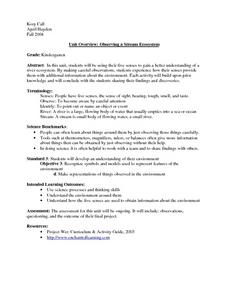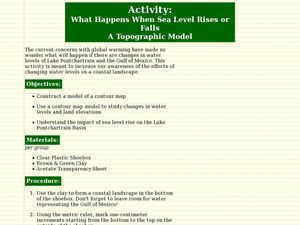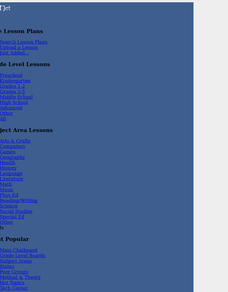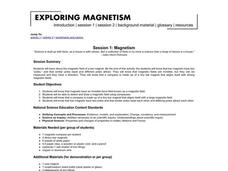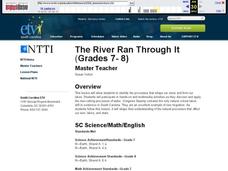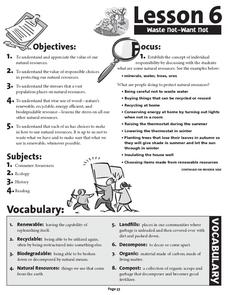Curated OER
Cookie Topography
Students construct a cross section diagram showing elevation changes on a "cookie island." Using a chocolate chip cookie for an island, they locate the highest point in centimeters on the cookie and create a scale in feet. After tracing...
Curated OER
One Size Fits All?
Young scholars describe the differences between an estimate and a guess. They create reasonable estimates based on comparison and activities. Students explain how estimation is helpful in showing the relative size on a scale. They...
Curated OER
How Many Animals?
Students use their math skills to develop estimates for the population of several animal species native to the Austrailian rainforest. It is a simulation that researchers at the Center for Rainforest Studies in Australia perform to...
Curated OER
Exploring Tessellations
Fifth graders examine how to make tessellations. In this tessellation activity, 5th graders review the meaning of the word "polygon" while the teacher shows them various examples. They practice making tiling patterns or tessellation's...
Curated OER
Observing a Stream Ecosystem
Students use their five senses to explore a river ecosystem. They experience how their senses provide them with additional information about the environment through the use of teacher made stream boxes.
Curated OER
Can You Measure Up?
Students use technology to visit websites where they play interactive games, gather information to complete activity sheets, and complete online projects. One lesson plan using 'Inch By Inch' by Leo Lionni, takes students to an...
Curated OER
How Plants Spice Up Our Lives
Third graders study plants. In this biology lesson plan, 3rd graders label and identify parts of plants, identify spices obtained from plants, and determine what part of a plant a spice comes from by using taste, touch, smell and sight.
Curated OER
18th Century Microscope
Young scholars examine a microscope from the 18th century. In this microscope lesson, students investigate how it works, what it was used for and how the tool has evolved through the years. Young scholars also build knowledge on how...
Curated OER
Presidents
Students conduct a research project. In this United States Presidents lesson, students draw a presidents name out of a box and complete a research activity on their president. Research options include writing a two page paper,...
Curated OER
An application of the Parallax Effect
In this parallax effect activity, students observe 2 photographs taken of an active area of the sun by 2 STEREO satellites and 1 photograph taken of the same active area of the sun by the SOHO satellite. Students observe the shift in...
Curated OER
Genetics: Integrated with History and Art
Students work cooperatively in pairing chromosomes, created statistical genetic babies using the face lab, constructed a color DNA booklet and demonstrated mitosis in a flip book.
Curated OER
Archaeological Soils
Students evaluate how archaeologists use soils to interpret sites and determine components of a soil sample.
Curated OER
Flip's Flag
Fifth graders apply the symmetry and angle properties of polygons and use fractions to express the relationships between the areas of rectangles, squares, and triangles. They analyze various country flags and develop mathematical...
Curated OER
Traditional American Indian Lodges
Young scholars explore the mathematical properties of traditional American Indian lodges. They examine the effect of increasing sides of a polygon, calculate the surface area of prisms and cylinders, and construct a classroom size...
Curated OER
Adopt An Insect
This lesson plan combines a creative building activity with analyzing a butterfly photograph and using problem solving to complete the puzzle. It blends art and science very well. Students will learn and enjoy the process. The extension...
Curated OER
What Happens When Sea Level Rises or Falls
Students examine the impact of sea level on land formations. In this geography and map activity, students construct a contour map model illustrating how much of the clay "coastline" is covered as water is added. Metric measurement is...
Curated OER
The Skeletal System
Students research the skeletal system. In this anatomy instructional activity, students measure their bodies to find the approximate length of their bones. They draw and cut out each of the bones and then attach them using brads or...
Curated OER
Which Triangles are Right
Students apply properties of right triangles to solve problems. In this geometry lesson plan, students identify axioms and theorems using examples.
Curated OER
Top Budget-Friendly Ways to Include Interactive Technology in the Classroom
Inspire student achievement and participation with multimedia activities.
Curated OER
Surface to Volume Ratios
High schoolers measure the rate of diffusion and to calculate the surface area to volume ratios of varying cell sizes. The lesson is very clearly organized with a useful student worksheet provided. They perform a lab experiment which is...
Curated OER
Magnetism
Students examine the concept of magnetism by doing several activities using magnets and compasses. They explore poles and polar repulsion and attraction.
Curated OER
The River Ran Through It
Students identify the processes that shape our rivers and form our lakes. They participate in hands-on and multimedia activities as they discover and apply the river-cutting processes of water.
Curated OER
Waste Not Want Not
Learners are introduced to the need to save natural resources. Through inquiry, hands-on activities, and problem solving, students increase their understanding of solid waste materials and the need to reduce, recycle, and reuse.
Curated OER
Discovering the Breakdown
Fifth graders investigate diseases of the respiratory system. In this respiratory system lesson, 5th graders research, using a variety of sources, the common diseases this system. They determine the causes of a breakdown in the system...




